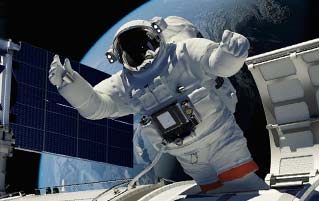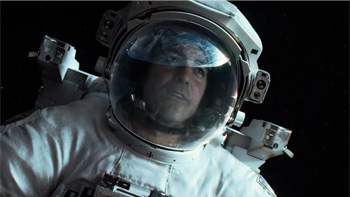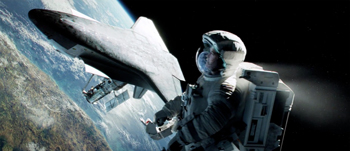4 Things About Space Travel You're Picturing Totally Wrong

In between extensive sessions of cardboard tube lightsaber training, we at Cracked love to ruin your day by detailing the many ways in which awesome looking things are nothing like you picture them, like space travel, for example. We've already told you how you have that stuff exactly wrong. But there's more, there's always more. Even if the plot of The Last Starfighter -- or, to a much lesser extent, Armada -- happened to you right now, you wouldn't have a clue how to actually deal with life in space. Here's why ...
Steering In Space Is Crazy Difficult
When you need to flee a mob of furious furries (as so often occurs in your misspent life) you simply point your car toward the state border and plant your foot on the accelerator until all your regrets disappear in the rearview mirror. And it works much the same way in films like Gravity. George Clooney uses his kickass jetpack to dash from the Hubble Space Telescope (which orbits at around 350 miles up) to the International Space Station (which orbits at around 230 miles up) in less time than it takes you to run to the weirdly wall-less movie theater bathroom.

"Spacemanning is so easy, I don't know what all those Earth-nerds are always bitching about."
The Reality:
If you increase your speed while circling Earth, you'll also increase the height of your orbit, which will increase the overall distance you're traveling. It's confusing even for those doing it -- early astronauts employed the "fucking gun it!" method while attempting to dock with other spacecraft, and missed their mark more often than a nervous kid on prom night.
See, the behavior of an orbiting spacecraft runs almost counter to our earthbound notions of speed and velocity. Again, the orbit itself provides some of the speed because of gravitational force. So to lower your orbit, you need to provide some kind of negative force, in this case, your rockets. But since you're getting closer to Earth -- and gravitational forces are getting stronger -- your kinetic energy actually increases, meaning you're likely to accelerate and fuck up your orbit to high heaven. So when George Clooney increased his speed to travel to the ISS, he almost certainly would have either blasted off into the void or crashed to Earth.

"That doesn't sound right; did you factor the power of my handsomeness into the calculation?"
Buzz Aldrin describes this as the "orbital paradox." And you can't just space jockey your way out of it, it takes more brains than balls. Aldrin, for example, holds a Doctorate of Science in astronautics from MIT. His thesis was "Line-Of-Sight Guidance Techniques For Manned Orbital Rendezvous." Just the title makes our brains hurt.
Staying In Space Is Harder Than You Think
The hardest part of getting to space is ... well, getting to space. Breaking free of Newton's pesky rules requires gut-punching Mother Earth with an amount of fuel that outweighs whatever you're trying to hurl into the great beyond. Once you manage to achieve orbit it's all slo-mo atmospheric shots and classical soundtracks. Easy livin'. Like in the sequel to 2001: A Space Odyssey where the Leonov approaches Discovery a decade later and finds it floating effortlessly above Jupiter's moon Io. Just spinning in place like the pencil of a fidgety Galactus.

"Look, just get to the ship, no crazy-ass star tunnel sequences this time, got it?"
The Reality:
If you were to take a 22-pound rock and fling it 620 miles straight up ... you would have superpowers. And an anger management problem. The gravitational force the rock would experience at that altitude is still about three-quarters of what it would be on the surface. That means our planet is constantly begging every single satellite we've put into orbit to come back like some kind of crazed ex. An object like the ISS must maintain an astounding steady speed of 17,000 miles per hour just to stay in its 200-plus mile orbit. Any less and it'll crash down to Earth. Any more, and it escapes our gravitational pull and rockets away into space. The ISS is, in fact, constantly losing altitude -- requiring the craft that dock with it to give it regular boosts ... just not too much of a boost.

"Well shit, now we gotta throw someone overboard."
Isaac Newton likened this phenomenon to a cannon perched atop a very high mountain. If the cannon were capable of firing its ball fast enough, the ball could fall toward the ground, but miss it entirely. Similarly, another great mind once said the knack to flying "lies in learning how to throw yourself at the ground and miss." That's what every single craft in orbit must perpetually do: Suck at hitting the ground.
Space Jetpacks Aren't Actually A Thing
Buried deep within the DNA of every human being lies the innate desire to fly through the air as if our ass were a jet engine, G-forces flapping our cheeks like the world's happiest bulldog sticking his head out the window of a 737. And in Gravity, George Clooney did it. He Supermanned through the void on a jet-powered space-recliner.

"C'mon, it's my turn to sit in the chair for a bit!"
"Hey! I'm commander, so I say who gets it!"
The Reality:
Clooney's high-tech throne is based on the Manned Maneuvering Unit, which dates back to 1984 when astronaut Bruce McCandless first helped develop it and then flew that sumbitch through open space completely untethered.

"Seriously? We can't even get some fishing line or something?"
In reality, the MMU's tiny compressed nitrogen thrusters weren't capable of moving it at anything beyond a space-crawl. Needless to say, zipping around like a coked-up hummingbird a la Gravity is out of the question. In the end, the MMU amounted to an interesting piece of technology that absolutely no one needed. Following 1985's Challenger disaster -- and taking into consideration the fact that space shuttles can just park up directly beside whatever astronauts need to work on -- NASA reevaluated their policy and scrapped the MMU in favor of the Simplified Aid For EVA Rescue. Or SAFER, which is somehow a lamer acronym than the phonetic "moo."
Real Spacecraft Are Astoundingly Primitive
In the Star Wars universe, new spaceships happen with the regularity of iPhone models. Hell, if NASA would take a cue from Hollywood and roll out some toys of all their sweet new ships and rovers and such, they could supplement their income so hard we'd all have rocket-pools on Mars by now.
The Reality:
The vehicles we trust to boot some of our most brilliant minds clear off the face of the planet are less like the futuristic ships in Interstellar and more like your cousin's beat-up Datsun. Take a look at this:

You can almost see the "My other ride is your Motherland" bumper sticker.
That's a Russian Soyuz, the spacecraft that is our main way of transporting astronauts to the ISS since America's space shuttles have been relegated to the junkyard like a fleet of 1980s minivans. Originally designed in 1962, and harnessing the very latest in '50s technology, the Soyuz remained largely unchanged for three entire decades. It wasn't until 2010 that its computer systems finally went fully digital when they received an impressive upgrade capable of cutting the typically two-day trip to the ISS down to a measly six hours.
As a point of comparison, the phone you're probably using to read this article is approximately a bajillion times more powerful than that, give or take a jillion. Also, in lieu of a fancy touchscreen, the Soyuz features a cramped control panel on which an operator is forced to push buttons with a goddamn stick.

Which is literally an invention they had on Futurama.
So why, exactly, are we still lobbing astronauts off-world in the spacefaring equivalent of a flip phone? Well, because that's all they need. The Soyuz can dock, rendezvous, autopilot, reenter the atmosphere, and make one hell of a fondue. It's also maintained a truly stellar safety record throughout the years, negating any real necessity for change. It's basically the Volkswagen Beetle of spacecraft. And, much like your stubborn grandpa who won't upgrade his decades-old DeskPRO because it "still does the print-outs" -- the Soyuz is just all mankind needs to get by for now.
Justin writes more stuff here. Add him on Twitter if you dig guys with knuckle hair.
It's Spring Break! You know what that means: hot coeds getting loose on the beaches of Cancun and becoming imperiled in all classic beach slasher ways: man-eating shark, school of piranhas, James Franco with dreadlocks. There are so many films about vacations gone wrong, it's a chore to wonder if there's even such a thing as a movie vacation gone right. Amity Island and Camp Crystal Lake are out. So what does that leave? The ship from Wall-E? Hawaii with the Brady Bunch? A road trip with famous curmudgeon Chevy Chase? On this month's live podcast Jack O'Brien and the Cracked staff are joined by some special guest comedians to figure out what would be the best vacation to take in a fictional universe. Tickets are $7 and can be purchased here!
For more reasons why life in outer space is a total bummer, check out 6 Reasons Why Mass Space Travel Would Completely Suck and The 6 Weirdest Dangers Of Space Travel.
Subscribe to our YouTube channel, and check out How Space Travel Would Destroy Your Body, and other videos you won't see on the site!
Follow us on Facebook, and we'll follow you everywhere.